Silicides and Nitrides Formation in Ti Films Coated on Si and Exposed to (Ar-N2-H2) Expanding Plasma
Abstract
:1. Introduction
2. Materials and Methods
2.1. Ti Films Coated on Si (100) Wafers
2.2. Expanding Plasma Process
2.3. Nitriding Treatments
2.4. Investigations of Titanium Silicides and Nitrides
2.4.1. X-ray Diffraction (XRD) Measurements
2.4.2. Raman Spectroscopy Experiments
2.4.3. Secondary Ion Mass Spectrometry (SIMS) Investigations
2.4.4. Transmission Electron Microscopy (TEM)
3. Results
3.1. Crystallization of Ti in As-Deposited Ti Films and Ti Films Processed at 400 °C
3.2. Crystallization of TiSi and C49TiSi2 in Ti Films Processed at 500 °C
3.3. Crystallization of C54TiSi2 in Ti Films Processed at 600 °C
Formation of TiO2 and TiN Compounds
3.4. Crystallization of TiN at 800 °C
4. Discussion
4.1. Titanium Silicides
4.1.1. Formation of TiSi and C49TiSi2
4.1.2. Formation of C54TiSi2 Phase
4.2. Formation of TiN Phase
4.3. Reaction Process
- The diffusion of Si into grain boundaries and grains of Ti which leads to an expansion of Ti lattice at 400 °C. Simultaneously, the NHx species produced in (Ar-N2-H2) plasma react at the Ti film surface and N diffuses into the metal film.
- The crystallization and growth of TiSi consisting of very fine grains and C49TiSi2 consisting of larger grains from the bottom interface at 500 °C. TiSi is probably the main precursor of C49TiSi2. TiN of amorphous structure probably start to form in the Ti film.
- The crystallization of C54TiSi2 at 600 °C, mainly from the C49TiSi2 metastable phase, and the simultaneous growth of TiN of amorphous structure.
- The crystallization of TiN at 800 °C.
5. Conclusions
Acknowledgments
Author Contributions
Conflicts of Interest
References
- Ponon, N.K.; Appleby, D.J.R.; Arac, E.; King, P.J.; Ganti, S.; Kwa, K.S.K.; O’Neill, A. Effect of deposition conditions and post deposition anneal on reactively sputtered titanium nitride films. Thin Solid Films 2015, 578, 31–37. [Google Scholar] [CrossRef]
- Patsalas, P.; Kalfagiannis, N.; Kassavetis, S. Optical properties and plasmonic performance of titanium nitride. Materials 2015, 8, 3128–3154. [Google Scholar] [CrossRef]
- Barhai, P.K.; Kumari, N.; Banerjee, I.; Pabi, S.K.; Mahapatra, S.K. Study of the effect of plasma current density on the formation of titanium nitride and titanium oxynitride thin films prepared by reactive DC magnetron sputtering. Vacuum 2010, 84, 896–901. [Google Scholar] [CrossRef]
- White, N.; Campbell, A.L.; Grant, J.T.; Pachter, R.; Eyink, K.; Jakubiak, R.; Martinez, G.; Ramana, C.V. Surface/interface analysis and optical properties of RF sputter-deposited nanocrystalline titanium nitride thin films. Appl. Surf. Sci. 2014, 292, 74–85. [Google Scholar] [CrossRef]
- Bailey, E.; Ray, N.M.T.; Hector, A.L.; Crozier, P.; Petuskey, W.T.; McMillan, P.F. Mechanical properties of titanium nitride nanocomposites produced by chemical precursor synthesis followed by high-P,T treatment. Materials 2011, 4, 1747–1762. [Google Scholar] [CrossRef]
- Dong, S.; Chen, X.; Gu, L.; Zhou, X.; Xu, H.; Wang, H.; Liu, Z.; Han, P.; Yao, J.; Wang, L.; et al. Facile preparation of mesoporous titanium nitride microspheres for electrochemical energy storage. Appl. Mater. Interfaces 2011, 3, 93–98. [Google Scholar] [CrossRef] [PubMed]
- Subramanian, B.; Muraleedharan, C.V.; Ananthakumar, R.; Jayachandran, M. A comparative study of titanium nitride (TiN), titanium oxynitride (TiON), and titanium aluminum nitride (TiAlN) as surface coatings for bio implants. Surf. Coat. Technol. 2011, 205, 5014–5020. [Google Scholar] [CrossRef]
- Roquiny, P.; Bodart, F.; Terwagne, G. Colour control of titanium nitride coatings produced by reactive magnetron sputtering at temperature less than 100 °C. Surf. Coat. Technol. 1999, 116, 278–283. [Google Scholar] [CrossRef]
- Tsai, J.Y.; Apte, P. A thickness model for the TiSi2/TiN stack in the titanium silicide process module. Thin Solid Films 1995, 270, 589–595. [Google Scholar] [CrossRef]
- Guemmaz, M.; Mosser, A.; Parlebas, J.C. Electronic changes induced by vacancies on spectral and elastic properties of titanium carbides and nitrides. J. Electron Spectr. Relat. Phenom. 2000, 107, 91–101. [Google Scholar] [CrossRef]
- Griffiths, L.E.; Lee, M.R.; Mount, A.R.; Kondoh, H.; Ohta, T.; Pulham, C.R. Low temperature electrochemical synthesis of titanium nitride. Chem. Comm. 2001, 6, 579–580. [Google Scholar] [CrossRef]
- Wriedt, H.A.; Murray, J.L. The N-Ti (nitrogen-titanium) system. Bull. Alloy Phase Diagr. 1987, 8, 378. [Google Scholar] [CrossRef]
- Gong, Y.; Tu, R.; Goto, T. Microstructure and preferred orientation of titanium nitride films prepared by laser CVD. Mater. Trans. 2009, 50, 2028–2034. [Google Scholar] [CrossRef]
- Iyer, S.S.; Ting, C.Y.; Fryer, P.M. Ambient gas effects on the reaction of titanium with silicon. J. Electrochem. Soc. 1985, 132, 2240–2245. [Google Scholar] [CrossRef]
- Jeon, H.; Sukow, C.A.; Honeycutt, J.W.; Rozgonyi, G.A.; Nemanich, R.J. Morphology and phase stability of TiSi2 on Si. J. Appl. Phys. 1992, 71, 4269–4276. [Google Scholar] [CrossRef]
- Wang, L.L.; Peng, W.; Jiang, Y.L.; Li, B.Z. Effective Shottky barrier height lowering by TiN capping layer for TiSix/Si power diode. IEEE Electron Device Lett. 2015, 36, 597–599. [Google Scholar] [CrossRef]
- Perez-Rigueiro, J.; Herrero, P.; Jimenez, C.; Perez-Casero, R.; Martinez-Duart, J.M. Characterization of the interfaces formed during the silicidation process of Ti films on Si at low and high temperatures. Surf. Interface Anal. 1997, 25, 896–903. [Google Scholar] [CrossRef]
- Chaix-Pluchery, O.; Chenevier, B.; Matko, I.; Senateur, J.P.; La Via, F. Investigations of transient phase formation in Ti/Si thin film reaction. J. Appl. Phys. 2004, 96, 361–368. [Google Scholar] [CrossRef]
- Lee, W.G.; Lee, J.G. Enhancement of TiSi2 formation during rapid thermal annealing in N2 by the presence of native oxide. J. Electrochem. Soc. 2002, 149, G1–G7. [Google Scholar] [CrossRef]
- Satka, A.; Liday, J.; Srnanek, R.; Vincze, A.; Donoval, D.; Kovac, J.; Vesely, M.; Michalka, M. Characterization of titanium disilicide thin films. Microelectron. J. 2006, 37, 1389–1395. [Google Scholar] [CrossRef]
- Ohya, S.; Chiaro, B.; Megrant, A.; Neill, C.; Barends, R.; Chen, Y.; Kelly, J.; Low, D.; Mutus, J.; O’Malley, P.J.J.; et al. Room temperature deposition of sputtered TiN films for superconducting coplanar waveguide resonators. Supercond. Sci. Technol. 2014, 27, 015009. [Google Scholar] [CrossRef]
- Cabioch, T.; Alkazaz, M.; Beaufort, M.-F.; Nicolai, J.; Eyidi, D.; Eklund, P. Ti2AlN thin films synthesized by annealing of (Ti+Al)/AlN multilayers. J. Mater. Res. Bull. 2016, 80, 58–63. [Google Scholar] [CrossRef]
- Wu, J.D.; Wu, C.Z.; Zhong, X.X.; Song, Z.M.; Li, F.M. Surface nitridation of transition metals by pulsed laser irradiation in gaseous nitrogen. Surf. Coat. Technol. 1997, 96, 330–336. [Google Scholar] [CrossRef]
- Jauberteau, I.; Merle-Mejean, T.; Touimi, S.; Weber, S.; Bessaudou, A.; Passelergue, A.; Jauberteau, J.L.; Aubreton, J. Expanding microwave plasma process for thin molybdenum films nitriding: Nitrogen diffusion and structure investigations. Surf. Coat. Technol. 2011, 205, S271–S274. [Google Scholar] [CrossRef]
- Jauberteau, I.; Jauberteau, J.L.; Touimi, S.; Merle-Mejean, T.; Weber, S.; Bessaudou, A. A thermochemical process using expanding plasma for nitriding thin molybdenum films at low temperature. Engineering 2012, 4, 857–868. [Google Scholar] [CrossRef]
- Jauberteau, I.; Mayet, R.; Cornette, J.; Bessaudou, A.; Carles, P.; Jauberteau, J.L.; Merle-Mejean, T. A reduction-nitridation process of molybdenum films in expanding microwave plasma: Crystal structure of molybdenum nitrides. Surf. Coat. Technol. 2015, 270, 77–85. [Google Scholar] [CrossRef]
- Zaumseil, P. High resolution characterization of the forbidden Si 200 and Si 222 reflections. J. Appl. Cryst. 2015, 48, 528–532. [Google Scholar] [CrossRef] [PubMed]
- Stan, G.E.; Popa, A.C.; Galca, A.C.; Aldica, G.; Ferreira, J.M.F. Strong bonding between sputtered bioglass-ceramicfilms and Ti-substrates implants induced by atomic inter-diffusion post-deposition heat treatment. Appl. Surf. Sci. 2013, 280, 530–538. [Google Scholar] [CrossRef]
- Teoh, L.G.; Lee, Y.C.; Chang, Y.S.; Fang, T.H.; Chen, H.Q. Preparation and characterization of nanocrystalline titanium dioxide with a surfactant mediated method. Curr. Nanosci. 2010, 6, 1–5. [Google Scholar] [CrossRef]
- Hristova, E.; Arsov, L.I.; Popov, B.N.; White, R.E. Ellipsometric and Raman spectroscopic study of thermally formed films on titanium. J. Electrochem. Soc. 1997, 144, 2318–2323. [Google Scholar] [CrossRef]
- Barros, A.D.; Albertin, K.F.; Miyoshi, J.; Doi, I.; Diniz, J.A. Thin titanium oxide films deposited by e-beam evaporation with additional rapid thermal oxidation and annealing for ISFET applications. Microelectron. Eng. 2010, 87, 443–446. [Google Scholar] [CrossRef]
- Nemanich, R.J.; Fiordalice, R.W.; Jeon, H. Raman scattering characterization of titanium silicide formation. IEEE J. Quantum Electron. 1989, 25, 997–1002. [Google Scholar] [CrossRef]
- Constable, C.P.; Yarwood, J.; Münz, W.D. Raman microscopic studies of PVD hard coatings. Surf. Coat. Technol. 1999, 116, 155–159. [Google Scholar] [CrossRef]
- Bhaskaran, M.; Sriram, S.; Short, K.T.; Mitchell, D.R.G.; Holland, A.S.; Reeves, G.K. Characterization of C54 titanium silicide thin films by spectroscopy, microscopy and diffraction. J. Phys. D Appl. Phys. 2007, 40, 5213–5219. [Google Scholar] [CrossRef]
- Vishnyakov, V.; Lu, J.; Eklund, P.; Hultman, L.; Colligon, J. Ti3SiC2-formation during Ti-C-Si multilayer deposition by magnetron sputtering at 650 °C. Vacuum 2013, 93, 56–59. [Google Scholar] [CrossRef]
- Jauberteau, I.; Bessaudou, A.; Mayet, R.; Cornette, J.; Jauberteau, J.L.; Carles, P.; Merle-Mejean, T. Molybdenum nitride films: Crystal structures, synthesis, mechanical, electrical and some other properties. Coatings 2015, 5, 656–687. [Google Scholar] [CrossRef]
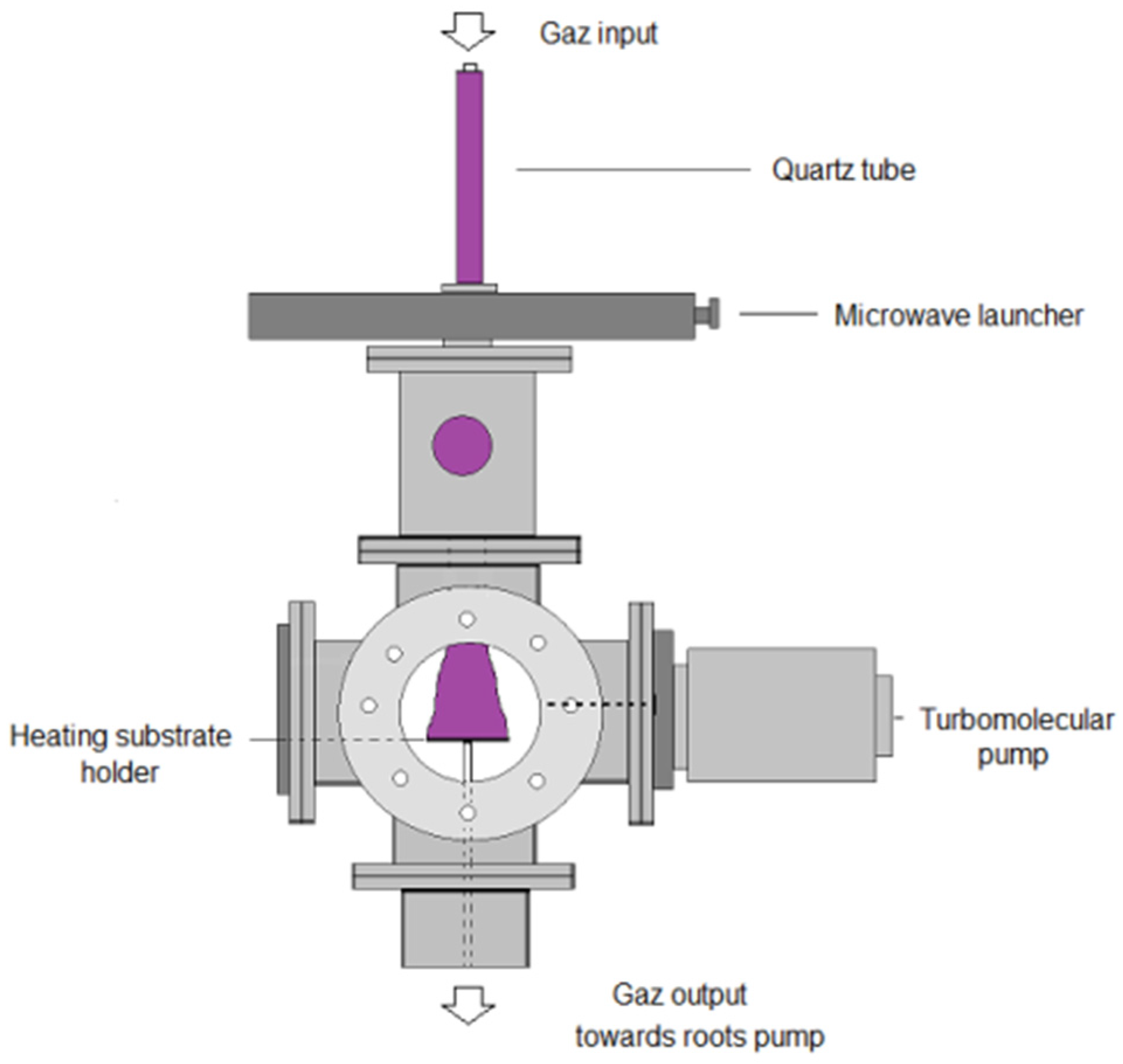
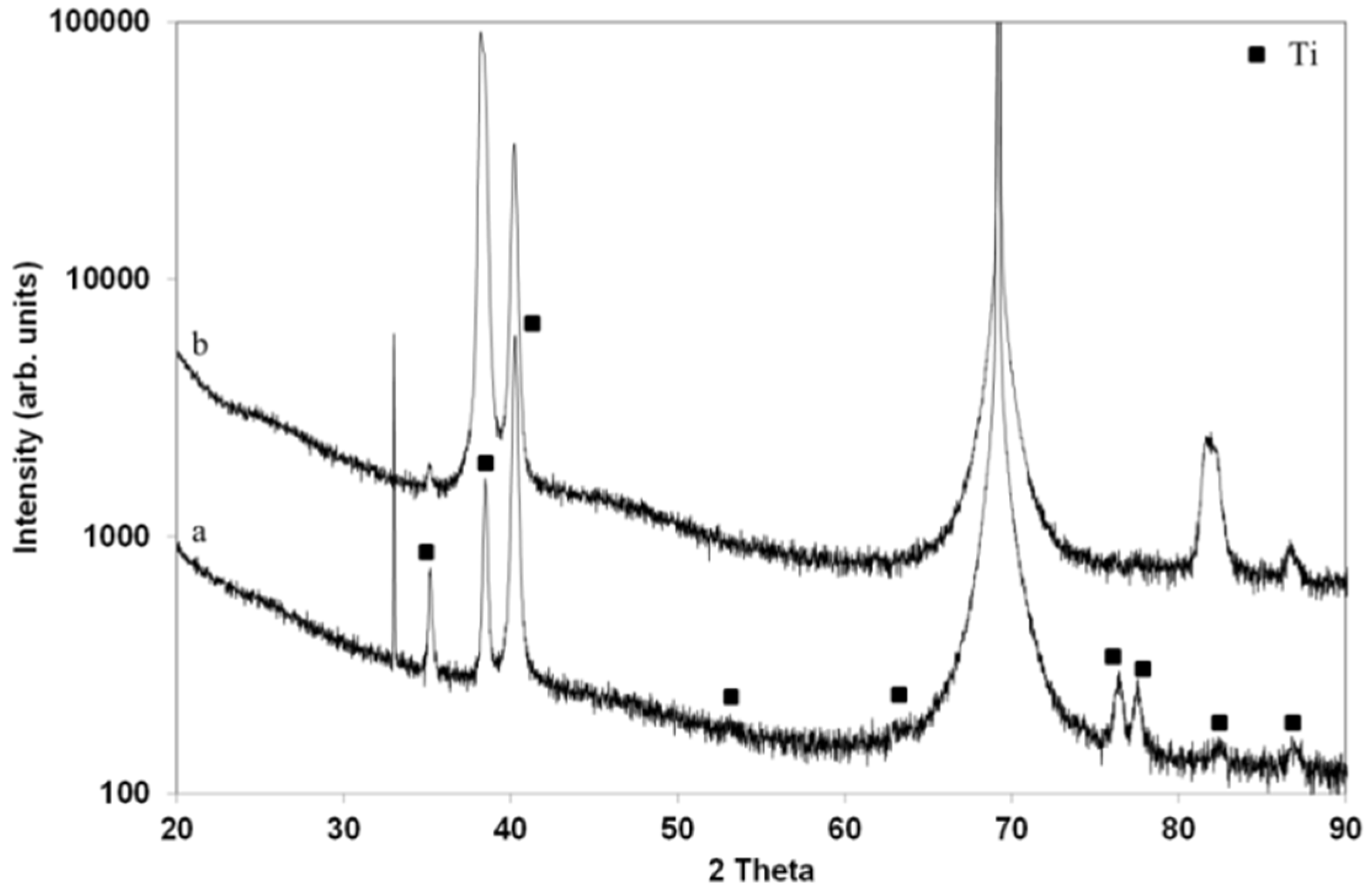
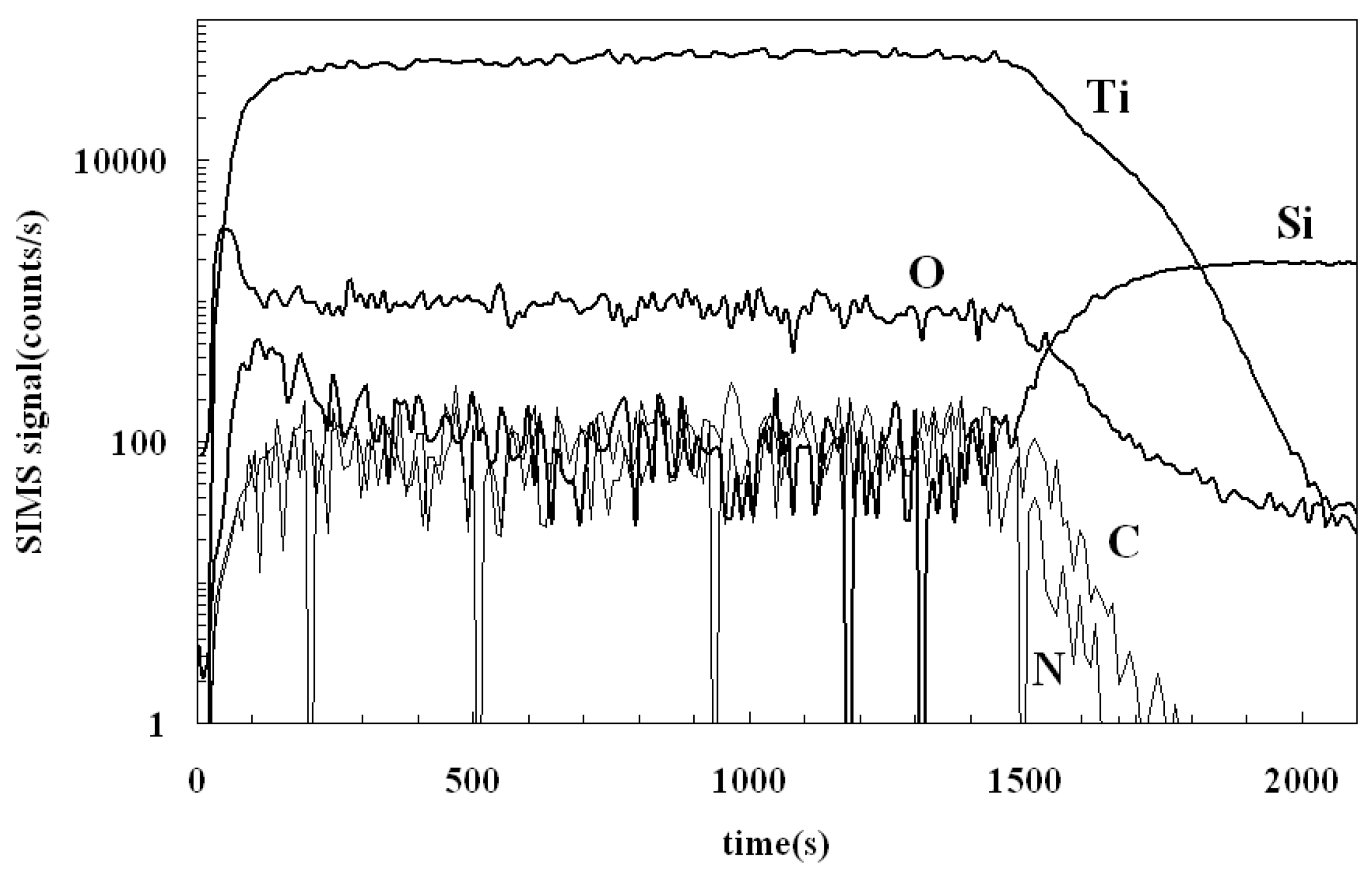
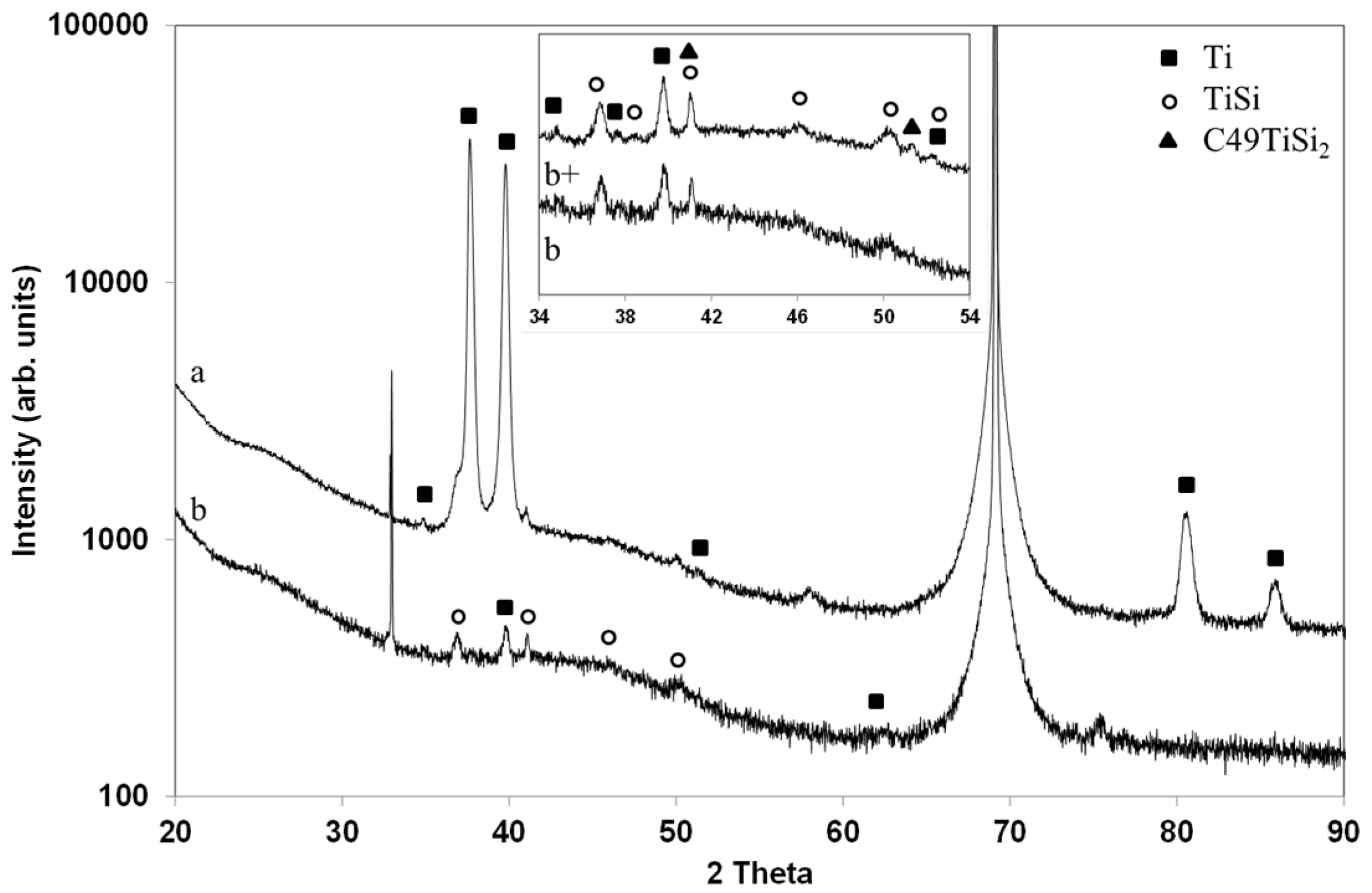
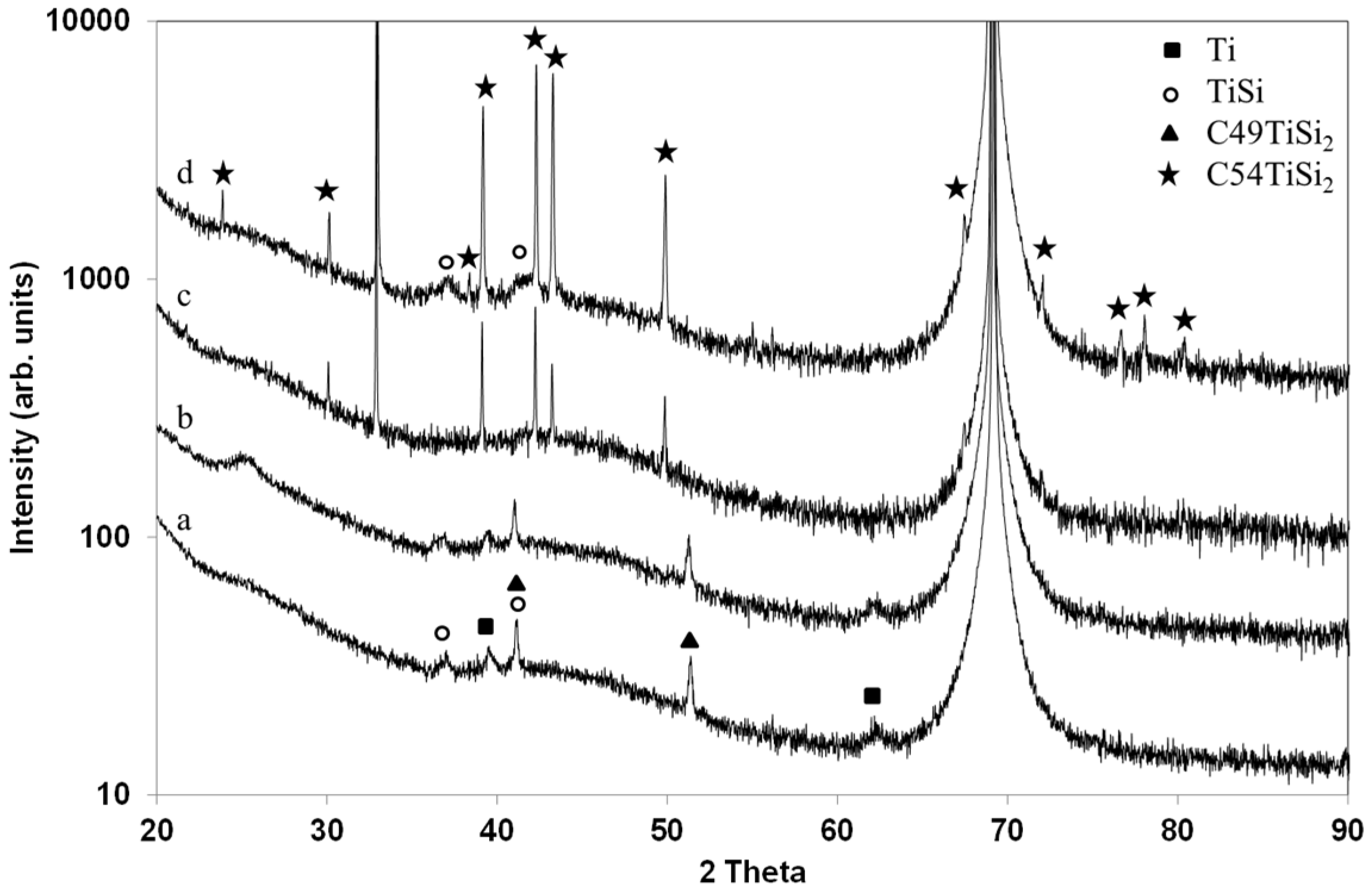



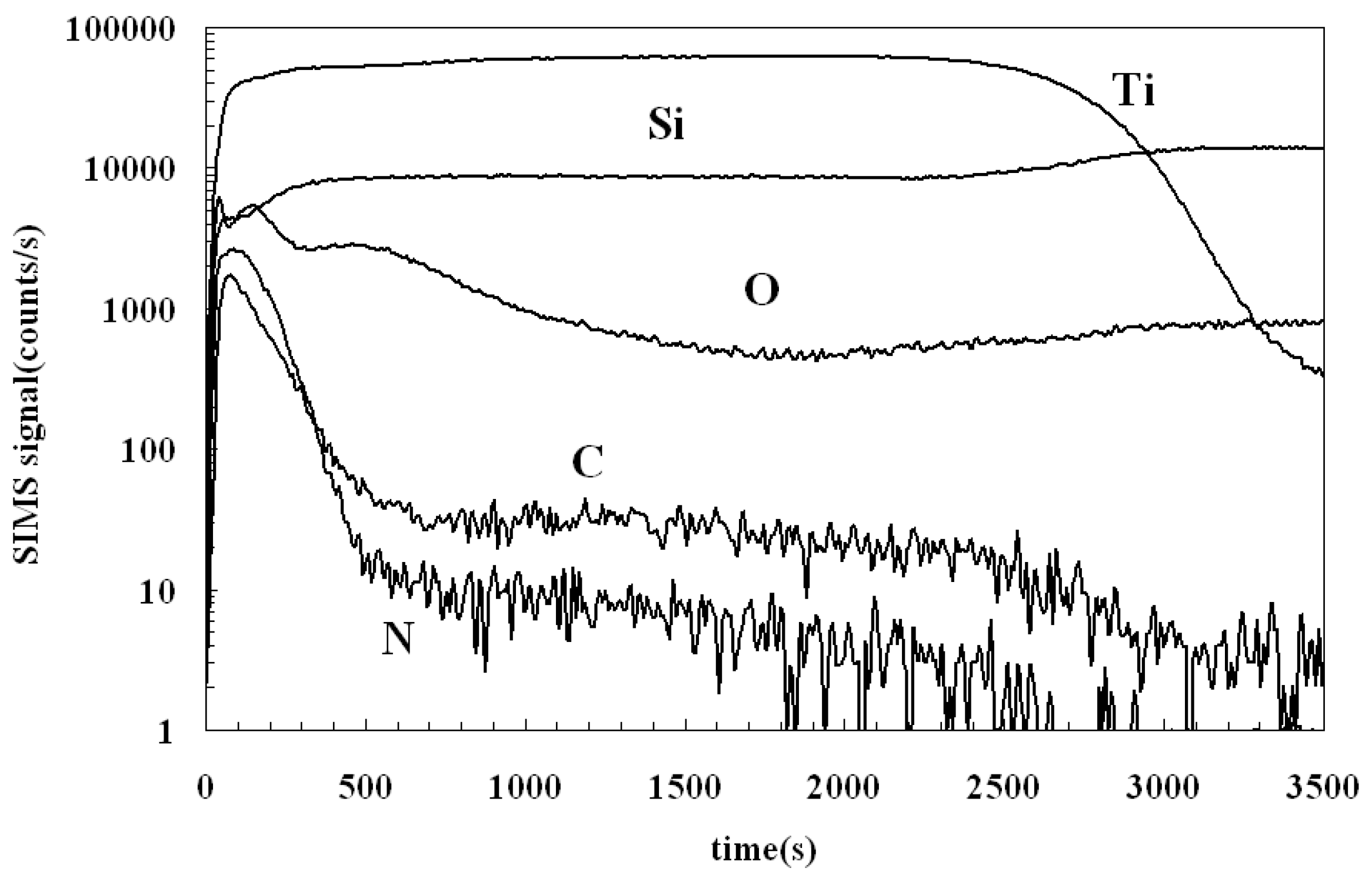
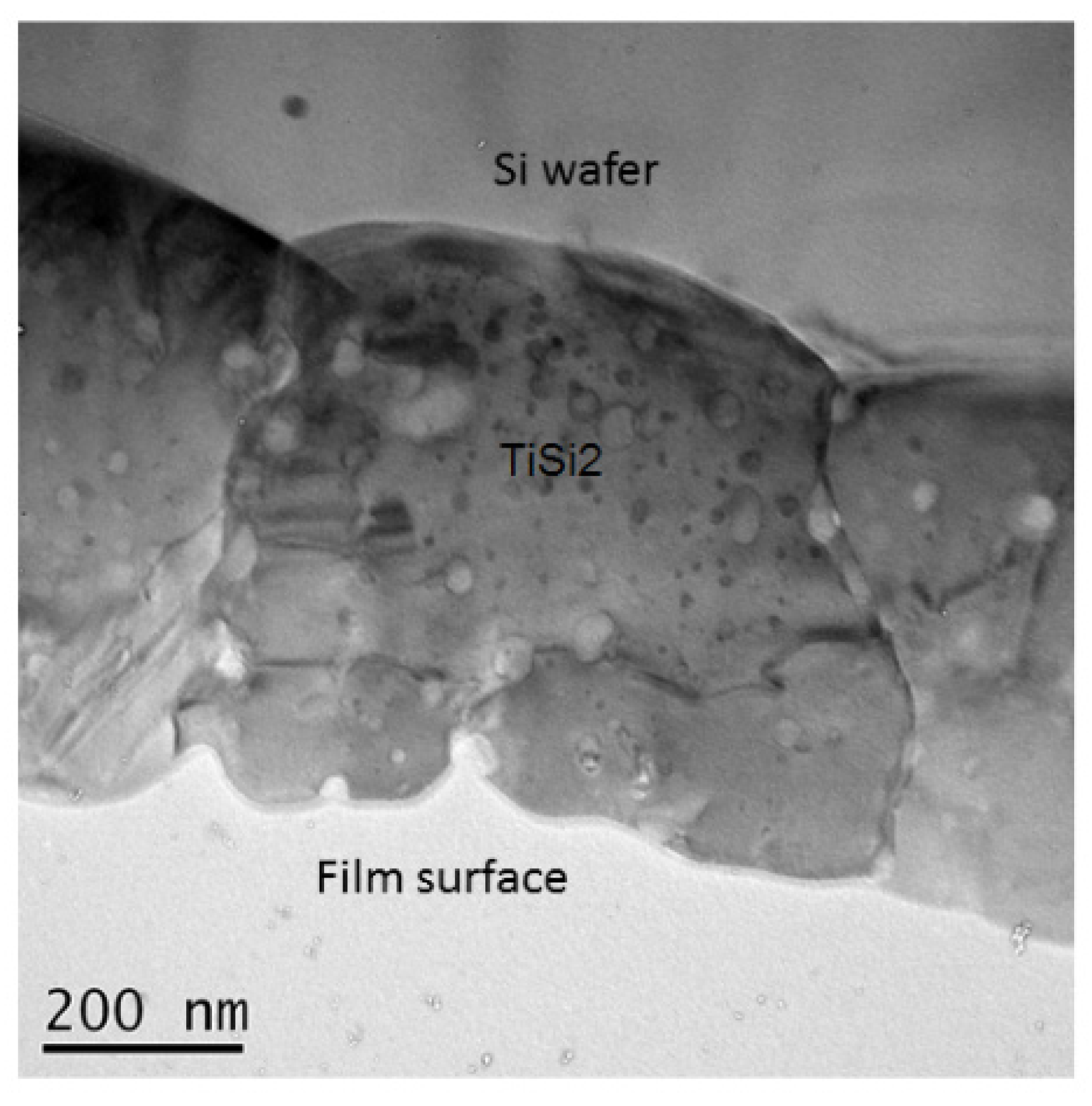
© 2017 by the authors. Licensee MDPI, Basel, Switzerland. This article is an open access article distributed under the terms and conditions of the Creative Commons Attribution (CC BY) license ( http://creativecommons.org/licenses/by/4.0/).
Share and Cite
Jauberteau, I.; Mayet, R.; Cornette, J.; Mangin, D.; Bessaudou, A.; Carles, P.; Jauberteau, J.L.; Passelergue, A. Silicides and Nitrides Formation in Ti Films Coated on Si and Exposed to (Ar-N2-H2) Expanding Plasma. Coatings 2017, 7, 23. https://doi.org/10.3390/coatings7020023
Jauberteau I, Mayet R, Cornette J, Mangin D, Bessaudou A, Carles P, Jauberteau JL, Passelergue A. Silicides and Nitrides Formation in Ti Films Coated on Si and Exposed to (Ar-N2-H2) Expanding Plasma. Coatings. 2017; 7(2):23. https://doi.org/10.3390/coatings7020023
Chicago/Turabian StyleJauberteau, Isabelle, Richard Mayet, Julie Cornette, Denis Mangin, Annie Bessaudou, Pierre Carles, Jean Louis Jauberteau, and Armand Passelergue. 2017. "Silicides and Nitrides Formation in Ti Films Coated on Si and Exposed to (Ar-N2-H2) Expanding Plasma" Coatings 7, no. 2: 23. https://doi.org/10.3390/coatings7020023




